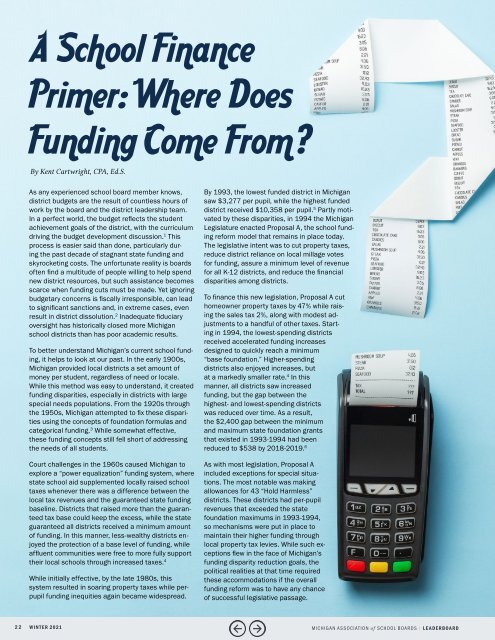MASB Leaderboard Winter 2021 Edition
The Battle Creek Public Schools Board of Education is featured on page 11!
The Battle Creek Public Schools Board of Education is featured on page 11!
- No tags were found...
Create successful ePaper yourself
Turn your PDF publications into a flip-book with our unique Google optimized e-Paper software.
By Kent Cartwright, CPA, Ed.S.<br />
As any experienced school board member knows,<br />
district budgets are the result of countless hours of<br />
work by the board and the district leadership team.<br />
In a perfect world, the budget reflects the student<br />
achievement goals of the district, with the curriculum<br />
driving the budget development discussion. 1 This<br />
process is easier said than done, particularly during<br />
the past decade of stagnant state funding and<br />
skyrocketing costs. The unfortunate reality is boards<br />
often find a multitude of people willing to help spend<br />
new district resources, but such assistance becomes<br />
scarce when funding cuts must be made. Yet ignoring<br />
budgetary concerns is fiscally irresponsible, can lead<br />
to significant sanctions and, in extreme cases, even<br />
result in district dissolution. 2 Inadequate fiduciary<br />
oversight has historically closed more Michigan<br />
school districts than has poor academic results.<br />
To better understand Michigan’s current school funding,<br />
it helps to look at our past. In the early 1900s,<br />
Michigan provided local districts a set amount of<br />
money per student, regardless of need or locale.<br />
While this method was easy to understand, it created<br />
funding disparities, especially in districts with large<br />
special needs populations. From the 1920s through<br />
the 1950s, Michigan attempted to fix these disparities<br />
using the concepts of foundation formulas and<br />
categorical funding. 3 While somewhat effective,<br />
these funding concepts still fell short of addressing<br />
the needs of all students.<br />
Court challenges in the 1960s caused Michigan to<br />
explore a “power equalization” funding system, where<br />
state school aid supplemented locally raised school<br />
taxes whenever there was a difference between the<br />
local tax revenues and the guaranteed state funding<br />
baseline. Districts that raised more than the guaranteed<br />
tax base could keep the excess, while the state<br />
guaranteed all districts received a minimum amount<br />
of funding. In this manner, less-wealthy districts enjoyed<br />
the protection of a base level of funding, while<br />
affluent communities were free to more fully support<br />
their local schools through increased taxes. 4<br />
While initially effective, by the late 1980s, this<br />
system resulted in soaring property taxes while perpupil<br />
funding inequities again became widespread.<br />
By 1993, the lowest funded district in Michigan<br />
saw $3,277 per pupil, while the highest funded<br />
district received $10,358 per pupil. 5 Partly motivated<br />
by these disparities, in 1994 the Michigan<br />
Legislature enacted Proposal A, the school funding<br />
reform model that remains in place today.<br />
The legislative intent was to cut property taxes,<br />
reduce district reliance on local millage votes<br />
for funding, assure a minimum level of revenue<br />
for all K-12 districts, and reduce the financial<br />
disparities among districts.<br />
To finance this new legislation, Proposal A cut<br />
homeowner property taxes by 47% while raising<br />
the sales tax 2%, along with modest adjustments<br />
to a handful of other taxes. Starting<br />
in 1994, the lowest-spending districts<br />
received accelerated funding increases<br />
designed to quickly reach a minimum<br />
“base foundation.” Higher-spending<br />
districts also enjoyed increases, but<br />
at a markedly smaller rate. 4 In this<br />
manner, all districts saw increased<br />
funding, but the gap between the<br />
highest- and lowest-spending districts<br />
was reduced over time. As a result,<br />
the $2,400 gap between the minimum<br />
and maximum state foundation grants<br />
that existed in 1993-1994 had been<br />
reduced to $538 by 2018-2019. 6<br />
As with most legislation, Proposal A<br />
included exceptions for special situations.<br />
The most notable was making<br />
allowances for 43 “Hold Harmless”<br />
districts. These districts had per-pupil<br />
revenues that exceeded the state<br />
foundation maximums in 1993-1994,<br />
so mechanisms were put in place to<br />
maintain their higher funding through<br />
local property tax levies. While such exceptions<br />
flew in the face of Michigan’s<br />
funding disparity reduction goals, the<br />
political realities at that time required<br />
these accommodations if the overall<br />
funding reform was to have any chance<br />
of successful legislative passage.<br />
22 WINTER <strong>2021</strong> MICHIGAN ASSOCIATION of SCHOOL BOARDS | LEADERBOARD

















